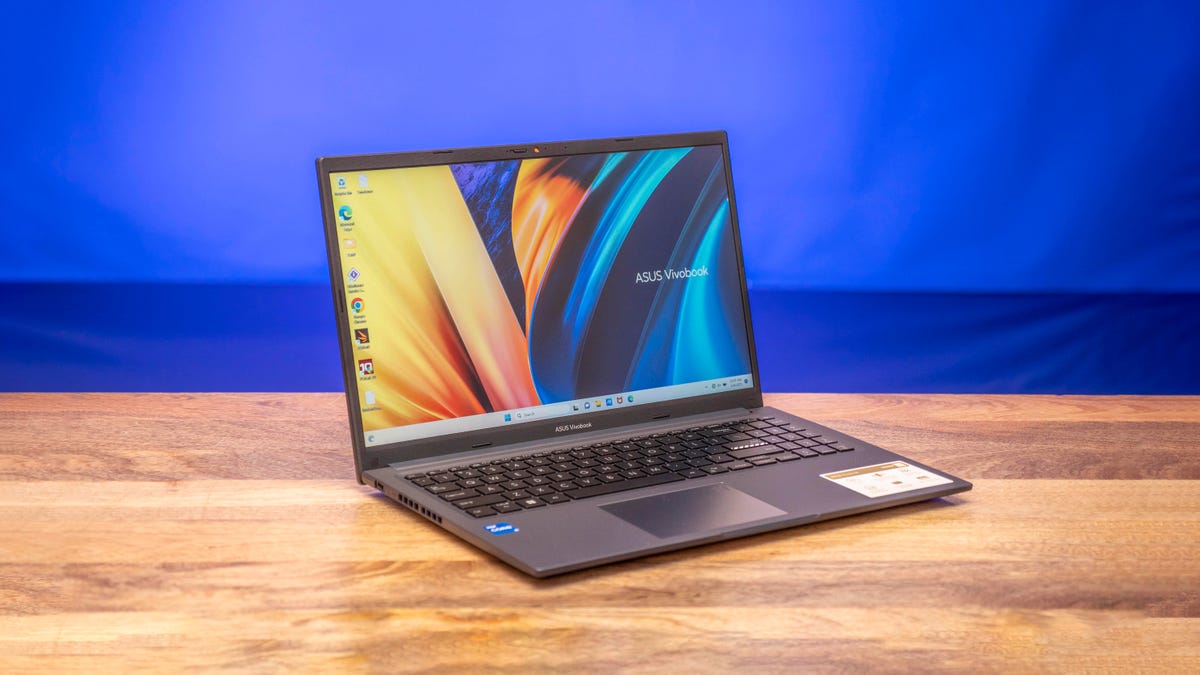Asus VivoBook F1502ZA Review: Big but Bland Budget Laptop

When shopping for a budget laptop, compromises must be made. Then the question quickly becomes, in which areas are you willing to make concessions for a lower price? The cut corners usually start with forgoing a solid metal chassis for a creaky plastic enclosure and a bright, vivid and high-resolution display for one that’s dim and dull. They likely end with a CPU that’s a generation behind the times along with a meager memory allotment and an undersized SSD. And it’s possible you’ll end up with a clacky keyboard without backlighting and a middling touchpad, too. The Asus VivoBook 15 forces you to make many of these compromises, but its plastic body looks classier than that of most budget laptops and doesn’t creak.
The biggest draw for the VivoBook F1502ZA I tested might be its 512GB SSD, though. That’s double the capacity usually on offer at this price. It’s currently on sale for $599 at Asus. The 8GB of RAM is standard for the price but for only $50 more at Amazon you can double it to 16GB of RAM, which will keep Windows working smoothly. Amazon also sells a model with 16GB of RAM and a 1TB SSD for $700, which might be the best value of the available VivoBook 15 configs. We like the fit and finish of the smaller and slightly pricier HP Pavilion Aero 13 and HP Pavilion 14, but the VivoBook 15 offers a roomier display for budget buyers. If getting the biggest display for your buck is your chief concern, however, then we’d steer you toward the 17-inch HP Laptop 17. And among 15-inch budget models, the Acer Aspire Vero is sturdier and more stylish.
Configuration as reviewed
| Geekbox | Asus VivoBook F1502ZA |
|---|---|
| Price as reviewed | $599 |
| Display size/resolution | 15.6-inch, FHD 1,920×1,080 16:9 aspect ratio, 60Hz refresh rate, 250 nits |
| CPU | 1.7GHz Intel Core i5-1240P |
| Memory | 8GB DDR4 3,200MHz RAM |
| Graphics | 128MB Intel UHD Graphics |
| Storage | 512GB PCIe NVMe SSD |
| Networking | Wi-Fi 6 (802.11ax) (Dual band), Bluetooth 5.3 |
| Operating system | Microsoft Windows Home 22H2 |
Our Asus VivoBook 15 (model F1502ZA-DS52P) is currently available at Asus for $599, which is $101 less than the regular price. It features an Intel Core i5-1240P CPU, 8GB of RAM, integrated Intel HD graphics and a 512GB SSD. A generation behind Intel’s current series, the Core i5-1240P is a member of Intel’s 28-watt P series that’s the middle child between the more efficient 15-watt U series and more performance-oriented 45-watt H series. It features Intel’s hybrid architecture with performance and efficiency cores; it has four performance cores, eight efficiency cores and a total of 16 processing threads. The 15.6-inch display has a full-HD resolution (1,920×1,080 pixels) and a widescreen 16:9 aspect ratio. While midrange and premium laptops have switched to a 16:10 or 3:2 screen ratio for more vertical workspace, most budget models are still 16:9. The display is rated for a paltry 250 nits of brightness, and our tests sadly confirmed this figure.
In labs testing, the VivoBook 15 finished at the back of a pack of laptops that feature similar specs — two of the competing models feature 12th-gen Core i5 CPUs like the VivoBook 15, while another features a previous-gen AMD Ryzen 5 5000 series processor. We also included Asus’s pricier Asus VivoBook 16X OLED laptop, which features a 12th-gen Core i7 part. Two of the four competing systems feature 8GB of RAM, and the other two offer 16GB of RAM. All rely on an integrated GPU. With the exception of a positive Cinebench score, the VivoBook 15 finished last among this group, and by considerable margins on Geekbench, 3DMark and our battery drain test. You can find better budget performance and battery life elsewhere.
Cool blue
At first glance, the VivoBook 15 looks like a step up from the usual budget fare. Part of its appeal is the gun-metal blue color of the plastic shell, which looks a bit more dressed up than a typical silver or dark gray enclosure. The plastic chassis is fairly solid, with just a little flex felt in the keyboard deck and lid behind the display. I’ve experienced creakier budget laptops.
The VivoBook 15 has a weak display hinge — a dead giveaway of a budget laptop — and any movement causes the screen to wobble. The hinge is able to rotate 180 degrees so you can lay the display down flat. I still have yet to encounter a scenario where I need to have my laptop resting horizontally and would gladly sacrifice the 180-degree flexibility for a firmer hinge.
The display may be wobbly, but the keyboard feels solid. The keys offer deep travel and snappy feedback for a pleasant typing experience. You also get a number pad, and its presence doesn’t result in any annoyingly shortened keys. One oddity to the keyboard we’ve seen with previous VivoBooks is the striped Enter key. There’s white-and-black striping along its bottom edge to maybe spice up the design or perhaps act as an aid for locating the key. Regardless, it’s a key that, I’d argue, is the last key other than the spacebar you need assistance in finding and would prefer Asus skip the distracting striping in the future.
The keyboard offers backlighting, which is a useful feature found on most laptops but not always a given on budget models. And it’s three-level backlighting so you can get the level just right depending on ambient lighting.
The touchpad looks and feels undersized, which is a common issue on laptops with widescreen 16:9 displays. A laptop with a taller 16:10 display not only provides more vertical space on the screen itself but also results in a wider wrist rest below the keyboard, which means more room for the touchpad. Though undersized, the touchpad offers smooth, accurate gliding and firm click response. It also features a fingerprint reader in the upper-right corner for easy, secure logins — another bonus at this price.
At 3.8 pounds, the VivoBook 15 is of average heft for its size, which is all you can ask for in a budget laptop. It’s a few ounces lighter than the more solid-feeling Acer Aspire Vero, which weighs an even four pounds. If you are looking for a more portable budget model and are willing to sacrifice some screen real estate, the 14-inch HP Pavilion 14 weighs 3.2 pounds, while the 13-inch HP Pavilion Aero 13 weighs just two pounds.
The Asus VivoBook F1502ZA has a privacy shutter for its webcam.
The VivoBook 15’s 15.6-inch, 1080p display is rather dull. It’s a 250-nit panel that our testing confirmed to be no brighter than its rating. Colors lack punch, and the limited contrast ratio means details are quickly lost in the brightest and darkest areas of an image. It’s no worse than a typical budget laptop’s display, but it’s certainly no better.
The 720p webcam above the display was actually a pleasant surprise. Most laptops today outside of the budget class feature 1080p cameras that result in crisper, better-balanced images. There was some noise evident, but images weren’t nearly as grainy as those of most 720p cameras. Colors and skin tones looked accurate, too. And the webcam has a physical cover you can slide across the lens to protect your privacy when you aren’t using the webcam, which is most of the time.
The speakers offered no such pleasant surprise. The audio output is tinny and muddy. Keep headphones handy for music playback. And you might want them when watching movies and shows since it’s hard to hear dialogue clearly.
The VivoBook 15’s ports are almost all located on the laptop’s right side, where you’ll find a USB Type-C port, two USB Type-A ports, an HDMI 1.4 port, a combo audio jack and the power connector. A lone USB 2.0 Type-A resides on the left side next to a cooling vent. A couple of notes on the USB ports: the USB-C port lacks Thunderbolt 4 support, and the two USB-A ports on the right offer faster USB 3.2 Gen 1 connectivity versus the slower USB 2.0 port on the left. All in all, the VivoBook 15 offers solid connectivity among budget laptops, but you miss out on the latest Wi-Fi 6E standard. The VivoBook offers Wi-Fi 6 wireless networking.
There are no deal-breaking misfires with the VivoBook 15, and we do appreciate getting a 512GB SSD, which is spacious for the price. And we like the affordable upgrades that double the RAM and SSD that are available at Amazon. Plus, it’s one of the better-looking budget laptops you’ll find. However, the dull display and weak speakers quickly remind us that the VivoBook 15 is, indeed, a member of the budget category. HP has a number of budget models in a variety of sizes that we like better, and we prefer the unique and eco-friendly Acer Aspire Vero among 15-inch budget models.
The review process for laptops, desktops, tablets and other computer-like devices consists of two parts: Performance testing under controlled conditions in the CNET Labs, and extensive hands-on use by our expert reviewers. This includes evaluating a device’s aesthetics, ergonomics and features. A final review verdict is a combination of both objective and subjective judgments.
The list of benchmarking software we use changes over time as the devices we test evolve. The most important core tests we’re currently running on every compatible computer include: Primate Labs Geekbench 5, Cinebench R23, PCMark 10 and 3DMark Fire Strike Ultra.
A more detailed description of each benchmark and how we use it can be found in our How We Test Computers page.
Geekbench 5 (multicore)
Asus VivoBook 16X OLED 7,984Acer Aspire 5 A515 7,254Dell Inspiron 16 2-in-1 7,202HP Laptop 17 5,880Asus VivoBook F1502ZA 5,087
Cinebench R23 (multicore)
Asus VivoBook 16X OLED 12,385Asus VivoBook F1502ZA 10,813Dell Inspiron 16 2-in-1 8,181Acer Aspire 5 A515 8,144HP Laptop 17 7,098
3DMark Wild Life Extreme
Dell Inspiron 16 2-in-1 2,543Acer Aspire 5 A515 2,407Asus VivoBook 16X OLED 2,133HP Laptop 17 1,720Asus VivoBook F1502ZA 1,238
PCMark 10 Pro
HP Laptop 17 5,781Dell Inspiron 16 2-in-1 5,331Asus VivoBook 16X OLED 5,282Acer Aspire 5 A515 5,272Asus VivoBook F1502ZA 5,059
Online streaming battery drain test
Dell Inspiron 16 2-in-1 697HP Laptop 17 530Asus VivoBook 16X OLED 454Acer Aspire 5 A515 420Asus VivoBook F1502ZA 343
System configurations
| Asus VivoBook F1502ZA-DS52P | Microsoft Windows 11 Home; 1.7GHz Intel Core i5-1240P; 8GB DDR4 3,200MHz RAM; 128MB Intel UHD Graphics; 512GB SSD |
|---|---|
| Asus VivoBook 16X OLED F1603ZA-DS74 | Microsoft Windows 11 Home; 2.3GHz Intel Core i7-12700H; 16GB DDR4 3,200MHz RAM; 128MB Intel Iris Xe Graphics; 512GB SSD |
| Dell Inspiron 16 2-in-1 | Microsoft Windows 11 Home; 1.3GHz Intel Core i5-1235U; 8GB DDR4 3,200MHz RAM; 128MB Intel Iris Xe Graphics; 512GB SSD |
| HP Laptop 17 | Microsoft Windows 11 Home; 2.3GHz AMD Ryzen 5 5625U; 8GB DDR4 3,200MHz RAM; 512MB integrated AMD Radeon Graphics; 256GB SSD |
| Acer Aspire 5 A515 | Microsoft Windows 11 Home; 1.3GHz Intel Core i5-1235U; 16GB DDR4 3,200MHz RAM; 128MB Intel Iris Xe Graphics; 512GB SSD |
Source: CNET






 Live: French police arrest hundreds amid decline in violence in fifth night of unrest
Live: French police arrest hundreds amid decline in violence in fifth night of unrest








